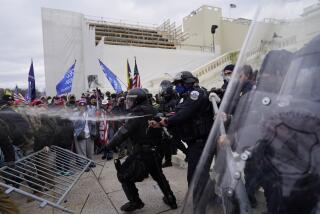Experts See Signs Global Terrorism Will Escalate
- Share via
WASHINGTON — Despite a 17-year low in incidents of international terrorism last year, senior U.S. specialists said Tuesday that they see “a variety of signs” that it will escalate against the United States and other countries.
U.S. officials are particularly concerned about new patterns in the movement of personnel and the transfer of funds by several extremist groups. “We can see the development of resources to support terrorism in areas of the world where certain groups have not operated before,” said one ranking specialist.
The assessment was the most ominous from senior U.S. specialists since the mid-1980s, the deadliest period since modern terrorism emerged in the late 1960s.
The most deadly example was the bombing one year ago today of the Israeli Embassy in Buenos Aires by Shiite extremists in Hezbollah, the pro-Iranian Party of God based in Lebanon. The blast killed 29 people and injured 242.
Although groups in Latin America and Asia share similar new capabilities, Hezbollah is the most active terrorist group, with tentacles now reaching “every continent except Antarctica,” the U.S. official added. He described it as the “most aggressive and most lethal” of the diverse foreign extremists.
International terrorists also appear to be shifting their targets from government facilities and diplomatic or military personnel to business and soft targets that are more vulnerable and more numerous. Recent targets of international terrorists include Western tourists and multinationals in Egypt and oil pipelines and Kentucky Fried Chicken franchises in Colombia.
The U.S. specialists’ conclusions were underscored by a bomb blast in Calcutta Tuesday that killed at least 45 and injured hundreds, which followed a series of bombings in Bombay four days earlier in which 300 people were killed.
Although U.S. specialists say that not enough evidence is available to link the attacks to international terrorism, two U.S. investigators have flown to India.
And in Rome Tuesday, a leading Iranian opposition figure was shot to death as he went to work. Mohammed Hussein Naghdi, a former diplomat, headed the Rome office of the opposition Mujahedeen Khalq. Although Tehran immediately denied responsibility, U.S. experts said Tuesday that they suspect the assassination was the latest in a series of Iranian attacks against opponents abroad.
The recent wave of incidents were a stark contrast to last year, when international terrorism attacks decreased from 567 in 1991 to 361 last year, the lowest total since 1975, the specialists said.
Although roughly 40%, or 141 incidents, involved American targets, there were no terrorism spectaculars aimed at the United States and only two Americans were killed in international terrorism incidents.
U.S. specialists attribute the new threat to three factors. The first is increasing activism worldwide by Islamic extremists, largely but not exclusively tied to Iran. They are an increasing threat to foreign targets inside the Middle East and also now outside the region.
Of all the state sponsors of international terrorism, U.S. officials now say that Iran is the only one still highly active.
Despite the moderate noises from Tehran since the Ayatollah Ruhollah Khomeini’s death in 1989 and Tehran’s help in freeing foreign hostages in Lebanon, Iran has not backed away from international terrorism, the U.S. experts said. Besides the killing Tuesday, Iran is believed to be responsible for between 40 and 50 incidents during the four-year rule of President Hashemi Rafsanjani.
“This regime is willing to use assassination and terror wherever necessary to eliminate those they see as enemies of their government,” the specialist said.
Earlier this month, a State Department spokesman said: “The Iranian intelligence service has been directly implicated in assassinations in Europe and elsewhere. Iran has been tied to several bombings and assassinations over the past year in the Middle East, Europe and Latin America.”
The second factor is new terrorism spawned by ethnic tension. U.S. officials are concerned, for example, that developments in the former Yugoslav federation will bring forth international terrorism as it spills over into Europe and other areas.
Because of instability or unrest, there are similar dangers in Somalia, former Soviet republics in Central Asia and Transcaucasia and South Asia, the experts said.
The third factor is related to regional conflicts involving the few remaining left-wing groups. Although the most visible and violent acts lately have been linked to Middle East and Indian groups, Latin America accounted for the largest number of terrorist attacks last year, where the world’s most active Marxist extremists reside in Peru, Columbia, Chile and Panama.
The Colombia National Liberation Army, for example, conducted the largest number of anti-American attacks in 1992.
But the prognosis includes some positive developments, including moves by Iraq, Libya and Syria to distance themselves, for diverse reasons, from sponsoring foreign terrorism.
“One of the major reasons statistics were down in 1992 was because state-sponsored acts were down,” said one senior U.S. expert.
More to Read
Sign up for Essential California
The most important California stories and recommendations in your inbox every morning.
You may occasionally receive promotional content from the Los Angeles Times.













